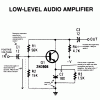Hello, I am fairly new to this and have a couple of questions (that may be considered dumb to more advanced members) but If I don't ask I will never know. I am having a problem reading schematics. I can read the very simple ones but when capacators and such are in, I have problems. First of all, when there is a schematic is everything positive voltage except where a ground is marked? I posted this picture with a couple questions on how the circuit works. Can you please help me figure out how to read these. For example, look at R4. Positive voltage flows into the top, and then it goes directly to '-V'... how is this not a short circuit? I'm not asking for a four-year college description but just for some tips. Thanks, I appreciate it.

